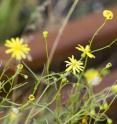Different recipes for success in the world of plants
In order to prevail against native plants, non-native plant species develop special strategies. These differ in part considerably from the propagation strategies of endemic plant species. Dr. Ingolf Kühn and Dr. Sonja Knapp of the Helmholtz Centre for Environmental Research (UFZ) reached this conclusion in a study published in the current issue of the scientific journal Ecology Letters. "These results are an argument in support of the view that the need to differentiate between native and non-native species in ecological systems remains," says Dr. Ingolf Kühn. Experts are currently debating whether this differentiation might be untenable, as it is only a question of the extent to which a plant species -- regardless of its origin -- is able to adapt to human-made conditions (Davis et al. (2011), Nature; Thompson et al. (2011) Trends in Ecology & Evolution). In the professional journal Trends in Ecology & Evolution (van Kleunen et al. (2011), Hulme et al. (2011)) a number of research groups counter with the argument that differentiating between these two groups contributes essentially to the understanding of modern ecosystems, as endemic and non-native species differ in many respects.
In their current study the UFZ researchers Dr. Ingolf Kühn and Dr. Sonja Knapp investigated this thesis and examined the question, whether the factors influencing the frequency of occurrence of non-native plant species are different from those for native species. Their investigations made use of the BiolFlor biological-ecologic data base for the characteristic features of flora in Germany, with more than 3,600 native and also established introduced species of ferns and flowering plants. They compared such features as life span, pollinating strategy and the occupation of different habitats and relate these features to the frequency of occurrence of a particular species.
Their results show that the frequency of occurrence of the introduced plant species is in fact influenced by other strategies than the frequency of occurrence of native species. "The introduced species profit in particular from the fact that they blossom later in the year. The flowering time is, on the other hand, not a relevant feature for the frequency of occurrence of native species," says Dr. Sonja Knapp. A number of the most common introduced plant species seek a time niche between October and December, during which most of the native competitors no longer blossom. The remaining pollinators, such as bees, bumble bees and certain other insects, then pollinate only these plants. If there are no longer sufficient pollinators during this time, many of the introduced plants, such as asters and other composite flowers, can undergo self-pollination and in this manner ensure their survival.
For many native species an advantageous strategy is to become well established in many different habitats, such as in forested areas and simultaneously in meadows. "On the other hand, for non-native species this appears to be less important. They do not need to occupy as many different habitats as the native species in order to achieve the same frequency of occurrence," says Dr. Sonja Knapp. The introduced plant species are so successful in the few habitats in which they occur that widespread adaptation is no longer necessary. This is probably related to the origin of many non-native plants in Germany: The successfully introduced species are above all species which have adapted to an agricultural environment, which accompany seeds or have the character of field herbs, or species able to adapt to disturbances such as found in urban habitats, and which therefore have good possibilities for spreading over large areas.
Non-native plant species are, initially, in competition with the native species. It is therefore understandable that newly arrived plants occupy niches not completely used by native species. Consequently, such non-native species frequently make use of these niches. Most introduced species pose no serious threats to our ecosystems. Around one per cent of the introduced species are, however, invasive. This means that their spread is so significant that they suppress native plants and disturb the ecosystem.
The UFZ researchers therefore believe that the differentiation between native and non-native plant species remains correct and important, even when they have been established in Germany for many centuries. Dr. Ingolf Kühn: "On the evolutionary time scale 500 years are a mere blinking of an eye. And because native and introduced species in fact exhibit differences in certain features, they should not all be considered together. Especially the importance of the early recognition of possible dangers due to the presence of introduced species requires knowledge of their origin."
Source: Helmholtz Centre For Environmental Research - UFZ
Other sources
- Different recipes for success in the world of plantsfrom Science DailyFri, 4 May 2012, 19:30:25 UTC
- Different recipes for success in the world of plantsfrom PhysorgFri, 4 May 2012, 15:00:27 UTC
